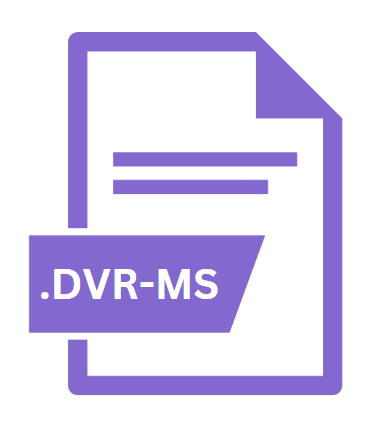.DVR-MS File Extension

Microsoft Digital Video Recording
| Developer | Microsoft |
| Popularity | |
| Category | Video Files |
| Format | .DVR-MS |
| Cross Platform | Update Soon |
What is an DVR-MS file?
The .DVR-MS file extension represents a digital video recording format developed by Microsoft.
Primarily associated with Windows XP Media Center Edition (MCE) and later versions, DVR-MS files are used to store recorded television content.
These files encapsulate audio and video streams, typically encoded in MPEG-2, along with metadata such as recording schedules and other relevant details.
DVR-MS files are essentially a wrapper for Windows Media Center’s recorded television programs, allowing users to pause, rewind, and record live TV.
More Information.
The history of the .DVR-MS file format is closely tied to the evolution of home entertainment and media consumption.
In the early 2000s, there was a growing demand for digital video recording solutions that could replace traditional VHS recorders.
Microsoft’s response was the Windows XP Media Center Edition, a version of Windows XP designed for home entertainment use.
The DVR-MS format was a key feature of this edition, enabling users to record TV shows, schedule future recordings, and organize their media libraries.
Unlike previous recording methods, DVR-MS files offered better integration with the Windows environment, providing users with the ability to manage their recordings directly from their PC.
This format supported features like time-shifting, which allows viewers to pause and resume live TV broadcasts, and easy transfer of recorded content to other devices.
Origin Of This File.
The .DVR-MS file format was introduced by Microsoft in 2002 alongside the release of Windows XP Media Center Edition.
The format was developed to facilitate the recording, playback, and management of television content on personal computers.
Before the advent of DVR-MS, personal computers lacked a standardized format for recording and managing TV content, limiting their functionality as entertainment centers.
Microsoft’s objective with DVR-MS was to create a format that integrated seamlessly with the Windows operating system, allowing users to turn their PCs into digital video recorders (DVRs).
File Structure Technical Specification.
The DVR-MS file format is a container format that encapsulates audio, video, and metadata. Here’s a breakdown of its structure:
- Container Format: DVR-MS is essentially a wrapper that contains various types of data streams. The format is based on the Advanced Systems Format (ASF), a proprietary container format developed by Microsoft.
- Video Stream: The video in DVR-MS files is typically encoded using the MPEG-2 codec, a widely used format for video compression, particularly in television broadcasting.
- Audio Stream: The audio stream is usually encoded in MPEG-1 Layer II or AC-3, both of which are common audio codecs for digital television.
- Metadata: In addition to audio and video, DVR-MS files also store metadata, which includes information like the title of the recorded program, the recording date and time, channel information, and more. This metadata helps in organizing and managing recordings within the Windows Media Center environment.
- File Size: The size of a DVR-MS file can be quite large, often several gigabytes for a standard-length television show, due to the use of MPEG-2, which is less efficient than more modern codecs like H.264 or H.265.
How to Convert the File?
Given the limitations of the DVR-MS format, users might want to convert these files to more modern and widely supported formats. Several tools are available for this purpose:
- HandBrake: A popular open-source video transcoder that supports DVR-MS files. Users can convert DVR-MS to formats like MP4 or MKV, which offer better compression and compatibility.
- VideoRedo: This is a paid software designed specifically for editing and converting TV recordings. It allows for the quick and easy conversion of DVR-MS files to other formats.
- FFmpeg: A command-line tool that supports a wide range of video formats, including DVR-MS. Users can use FFmpeg to convert DVR-MS files to formats like MP4, AVI, or MKV.
- Windows Media Encoder: Although an older tool, Windows Media Encoder can be used to convert DVR-MS files to WMV format, which is better supported by modern Windows versions.
Advantages And Disadvantages.
Advantages:
- Integrated with Windows Media Center: One of the main advantages of DVR-MS files is their seamless integration with Windows Media Center, making it easy for users to record, manage, and play back television content on their PCs.
- Support for Time-Shifting: DVR-MS files support time-shifting, which allows users to pause and resume live TV broadcasts, providing a more flexible viewing experience.
- Rich Metadata: The format includes metadata that enhances the organization and management of recorded TV programs, allowing users to search and sort their recordings by various criteria.
- Compatibility with Windows: DVR-MS files are natively supported by several Windows applications, including Windows Media Player and Windows Media Center.
Disadvantages:
- Large File Size: Due to the use of MPEG-2 compression, DVR-MS files are often large, which can quickly consume significant amounts of storage space.
- Limited Compatibility: While DVR-MS files work well within the Windows ecosystem, they are not as widely supported by third-party media players and non-Windows operating systems.
- Outdated Format: With the advent of newer formats like H.264 and H.265, which offer better compression and quality, DVR-MS is considered somewhat outdated.
- No Native Support on Modern Windows Versions: Later versions of Windows (starting with Windows 10) no longer include Windows Media Center, making it difficult to play DVR-MS files without third-party software.
How to Open DVR-MS?
Open In Windows
- Windows Media Player: On older versions of Windows (XP, Vista, 7, and 8), DVR-MS files can be played natively using Windows Media Player.
- Windows Media Center: On versions of Windows that include Windows Media Center, DVR-MS files can be managed and played directly within the Media Center interface.
- VLC Media Player: This popular third-party media player supports DVR-MS files across different versions of Windows, including Windows 10 and 11.
Open In Linux
- VLC Media Player: Similar to macOS, VLC Media Player on Linux can handle DVR-MS files.
- FFmpeg: For better compatibility, users can convert DVR-MS files to other formats using FFmpeg.
Open In MAC
- VLC Media Player: DVR-MS files can be played on macOS using VLC Media Player, which supports a wide range of video formats.
- FFmpeg: Users can convert DVR-MS files to a more macOS-friendly format using FFmpeg before playing them.












